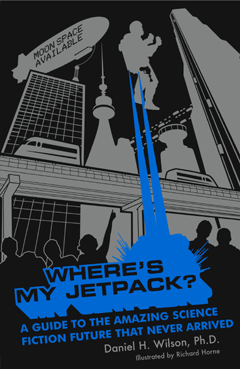Where's My Jetpack?
Air Date: Week of May 11, 2007

Where's My Jetpack bookcover (Courtesy of Bloomsbury USA)
Where are the hoverboards, jetpacks, underwater cities and flying cars that Hollywood promised us decades ago? Author Daniel Wilson tells host Steve Curwood what he learned while writing his new book "Where's My Jetpack: A Guide to the Amazing Science Fiction Future that Never Arrived."
Transcript
CURWOOD: Science fiction, as a means of prediction, has long been a cultural staple. The fictional cannon of Jules Verne that shot people to the moon took less than a century to morph into the very real Saturn Five moon rocket of the Apollo program.
[ROCKET LAUNCH COUNT DOWN]
CURWOOD:And the ray gun of Buck Rogers back in the 1920’s foretold the laser.
[TALKING: Buck Rogers Radio Show “Buck Roger’s Origin Story (Excerpt)” from ‘Buck Rogers In The 25th Century Radio Serial’ (CBS/Mutual - 1932)]
CURWOOD: But what about the other fantastic stuff we heard about, especially during the high tech boom that followed world war two. You know, the time machines and x-ray vision don't seem to be anywhere in sight, not to mention flying cars and robots that do your laundry. Daniel Wilson is author of "Where's my Jetpack: A Guide to the Amazing Science Fiction Future that Never Arrived." He says some of the technologies of yesterday's tomorrow actually were invented, including the jetpack.
WILSON: So the jetpack was invented by a guy named Wendell Moore in the early 60's and he did it on an army grant and essentially it's just a, it's really a rocket pack. There's a chemical reaction that happens between really pure hydrogen peroxide and silver and it's just an expanding reaction so when these two get put together it's sort of a controlled explosion that thrusts you into the air. Now, this controlled explosion only lasts for about 30 seconds, which is a huge drawback and it's why the army didn't renew that grant [BOTH LAUGH] and it's why there were only a few copies made.
At this point unless you want to steal one from the Smithsonian, you can actually buy one from a Mexican guy named Juan Lazano. And there are a couple of other companies that will rent these out with celebrity impersonators flying them around. The problem though, like I said, is that jetpacks are much more sexy than they are practical and that 30 second time limit is a real killer.

Daniel Wilson (Courtesy of Daniel Wilson)
WILSON: None that I know of, yeah I was interested in that. It's true that Wendell Moore...
CURWOOD: So, wait, it's the safest form of transportation then?
WILSON: (Laughs) It's an experimental aircraft yeah, no one's bit it yet. Although Wendell Moore, you know, he tested this himself and ultimately he shattered one of his knees and decided never to strap one on again.
CURWOOD: So what inspired you in the first place to write this book? I mean, how did you come up with your list?
WILSON: Well, first of all I talked about things that I've always wanted. So, I grew up as a kid reading comic books and in the backs of comic books they have all these things you can buy. You can buy a real, live, hoverboard and then you get it home and you realize that this is made out of a vacuum cleaner and it's got to be plugged into the wall.
[BOTH LAUGH]
WILSON: And they conveniently forget to mention that this is going to have an electric cord. Or you know I went on several very misleading rides at Disneyland and I never really let go of that. As a kid you're really optimistic, you believe all these things are going to happen and then you reach a certain age and you say, "What happened to the future?" So I reached that age, and I wasn't doing anything else and so, I decided to go ahead and write “Where's My Jetpack?”

Where's My Jetpack bookcover (Courtesy of Bloomsbury USA)
WILSON: Well, well functional, see that's the thing. A lot of this stuff exists and in fact that's my whole point behind the book is that I'm not saying, "Oh look here's a pessimistic view on our non-future." Instead I'm going through every one of these and I'm saying, “Look this really exists or it has existed in the past and nobody wanted it. So, the technology I was surprised to find exists at all, even though it doesn't exist in the way we want it to, is teleportation and the thing that surprised me is that I'll talk to people....
CURWOOD: Wait a second you're saying "Beam me up Scotty" works?
WILSON: Right...So, you know I'll talk to people on the street or in bars and they have no idea that physicists routinely conduct teleportation experiments. You know this is real! We live in a world where you can teleport quantum particles over arbitrary distances. And the problem is that it's only quantum particles. So, things like photons, not things like people. Which is kind of good because the way teleportation actually works is a copy is made and the original is destroyed during the process. So, it's questionable whether you really want to do that to yourself.
CURWOOD: Now, one of the things that was, ah, back then that we haven't seen yet is smell-o-vision and you know, I think I'm ambivalent about that...
WILSON: Uh, you know, some of the topics I chose to talk about in the book, I chose them just because they reflected this wild optimism that was around in the 50's you know about technology and how great it would be and smell-o-vision I think is an example of that- where people run toward some goal without thinking what it would really be like. And I think that's great. [LAUGHS] I love that kind of creativity and so obviously smell-o-vision was not a big hit when It was used during one movie called" Scent of a Mystery" and the smells during the movie actually clued people in. You could figure out who the killer was based on these smells. But again, smell-o-vision is real!
CURWOOD: Well, I just can't resist asking you about something that was predicted that I'm not sure I'm disappointed that it didn't happen and that's the mind-reading device.
WILSON: Well, mind-reading devices are here. And they're here in two forms. One form is a lie detector system so these systems can figure out what you're thinking- at least figure out whether or not your lying- by using cameras that track the blood flow underneath the skin in your face and also by using slow-motion cameras to look at micro-expressions and micro-gestures that people make unconsciously.
But, where mind reading is really interesting is in a medical area where several companies and several academic institutions have brain-computer interfaces. So, in the non-invasive sense this is basically a hat that you wear that's covered with electrodes and it measures the electrical activity that's going on in your brain. In an invasive sense this is a sub-dural implant that's basically a lot of little electrodes that are poked in to the surface of your brain. So, for instance, if you're paralyzed they'll choose to put this in your motor cortex and then when you think about moving a limb that you can't move in reality, the computer can actually use machine-learning to figure out what you're trying to do- over time it learns what you're trying to do- and it then can actually move a cursor on a screen, or there's been an example where a, what, for lack of a better term is a "cyborg monkey," has been able to use it's brain to move an artificial limb in order to feed itself bananas. And before you ask no, they did not cut off the monkey's real arm. They just strapped it down.
CURWOOD: So, most of the things that you included in your book were things that were promised in movies and comic books in the 50's and 60's and 70's- they all suggested that we were going to be in this, well a Utopia of sorts in the future, where people could fly, cars just driving themselves, we live in a smart house, we would have x-ray vision, so what does that say about what we were dreaming about for ourselves and for society at that time?
WILSON: Well, I think that a lot of people thought that, you know, all of our problems would be solved by technology. And any problem they could think of pretty much there was a technological solution that was lurking in the near future. And above and beyond solving problems I think that there was this wild optimism that technology was not only going to solve our problems but that it was going to entertain us in ways that we could never imagine, so there's smell-o-vision, there are moon vacations and man exploring all the environments that we would like to explore and you know, with impunity. And I'm hoping that we continue toward that goal because I do want to have a space vacation and I still do want that hoverboard.
CURWOOD: Daniel Wilson is author of Where's My Jetpack: A Guide to the Amazing Science Fiction Future that Never Arrived. Thank you so much sir.
WILSON: Thank you for having me.
[Buck Rogers Radio Show “Buck Roger’s Origin Story (Excerpt)” from ‘Buck Rogers In The 25th Century Radio Serial’ (CBS/Mutual - 1932)]
[MUSIC: Anonymous composer “Clock Factory” from ‘Science Fiction Sounds’ (Columbia River Entertainment – 2001)]
Links
Living on Earth wants to hear from you!
Living on Earth
62 Calef Highway, Suite 212
Lee, NH 03861
Telephone: 617-287-4121
E-mail: comments@loe.org
Newsletter [Click here]
Donate to Living on Earth!
Living on Earth is an independent media program and relies entirely on contributions from listeners and institutions supporting public service. Please donate now to preserve an independent environmental voice.
NewsletterLiving on Earth offers a weekly delivery of the show's rundown to your mailbox. Sign up for our newsletter today!
 Sailors For The Sea: Be the change you want to sea.
Sailors For The Sea: Be the change you want to sea.
 The Grantham Foundation for the Protection of the Environment: Committed to protecting and improving the health of the global environment.
The Grantham Foundation for the Protection of the Environment: Committed to protecting and improving the health of the global environment.
 Contribute to Living on Earth and receive, as our gift to you, an archival print of one of Mark Seth Lender's extraordinary wildlife photographs. Follow the link to see Mark's current collection of photographs.
Contribute to Living on Earth and receive, as our gift to you, an archival print of one of Mark Seth Lender's extraordinary wildlife photographs. Follow the link to see Mark's current collection of photographs.
 Buy a signed copy of Mark Seth Lender's book Smeagull the Seagull & support Living on Earth
Buy a signed copy of Mark Seth Lender's book Smeagull the Seagull & support Living on Earth

